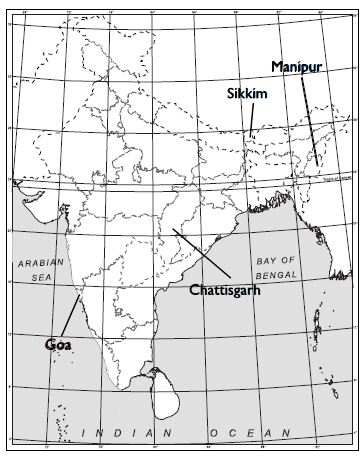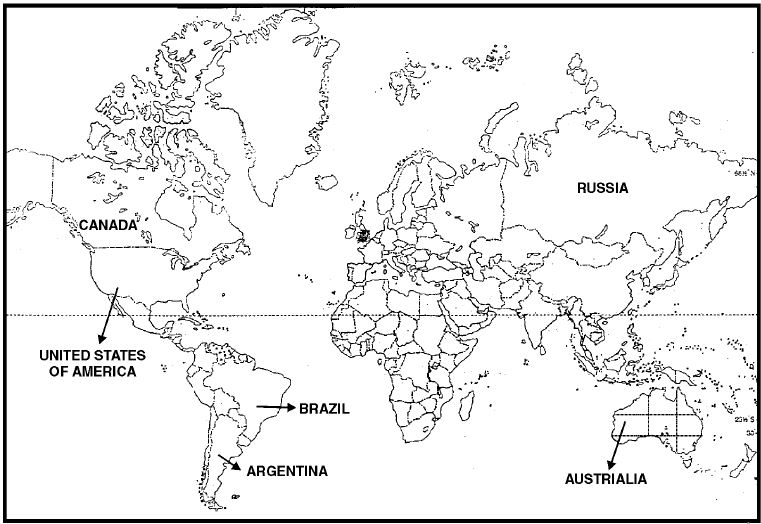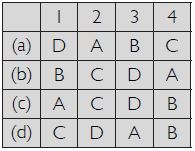Aasoka, the best online learning platform, has NCERT Solutions for Class 10th available online for free. Students can access these solutions at any time and at their own leisure. The questions are strictly based on the latest syllabus of Class 10th. Looking at the increasing demand for top NCERT Solutions, the subject matter experts at Aasoka have curated the solutions keeping in mind the student’s requirements.
With the help of the chapter “Federalism”, students of Class 10th will learn and understand the basics of federalism in layman’s language. The chapter has a detailed discussion of the general practice and theory of federalism in India. At the end of the chapter, there is a mention of a new and third tier of Indian federalism and local government.
Question 1:
Locate the following States on an outline political map of India: Manipur, Sikkim, Chhattisgarh and Goa.
Answer:
Question 2:
Identify and shade three federal countries (other than India) on an outline political map of the world.
Answer:
Question 3:
Point out one feature in practice of federalism in India that is similar to and one feature that is different from that of Belgium.
Answer:
Similar Feature: One similar feature between the federalism of India and Belgium is that both the countries have federations in which two levels of governments are present out of which the central government is more powerful as compared to the state governments.
Different Feature: Three types of linguistic groups are living in Belgium and three types of governments are present there. First one is the central government, second type is the state government and third type of government is community government which is elected by people belonging to one language community and has power related to issues of educational, cultural, linguistic aspects, etc.
In India, three levels of governments are there—central, state and local governments. There is no community government in India like that in Belgium.
Question 4:
What is the main difference between a federal form of government and a unitary one? Explain with an example.
Answer:
In a federal system of government, the central government is not authorised to instruct the state governments on any particular issue. State governments are free to work on any issue related to the state, according to its will. But in a unitary form of government, the central government can pass any order to the state or local governments on any specific issue.
Example. Many countries like India, U.S.A., Canada, Australia, Brazil, Argentina, etc., have a federal type of government. But countries like France, England, Japan, etc., have a unitary system of government.
Question 5:
State any two differences between the status of local self-government before and after the Constitutional amendment in 1992.
Answer:
Through the 73rd Constitutional Amendment in 1992, few Constitutional amendments were made for the proper working of the local self-governments. Two differences between the situations before and after the constitutional amendment in 1992 are given below:
Before 1992
- Local self-governments had no powers to collect taxes to meet their regular needs.
- There were no regular elections held in local self-governments.
After 1992
- Local self-governments were given powers to collect taxes for meeting their needs.
- It became mandatory to hold regular elections in local self- governments after every 5 years.
Question 6:
Since the United States is __________________ a type of federation, all the constituent states have equal powers and states are __________________ vis-a-vis the federal government. But India is a __________________ type of federation and some states have more power than others. In India, the __________________ government has more powers.
Answer:
Since the United States is a Coming together type of federation, all the constituent states have equal powers and states are stronger vis-a-vis the federal government. But India is a Holding together type of federation and some states have more power than other. In India, the Central government has more powers
Question 7:
Here are three reactions to the language policy followed in India.
Give an argument and an example to support any of these positions.
Sangeeta: The policy of accommodation has strengthened national unity.
Arman: Language based states have divided us by making everyone conscious of their language.
Harish: This policy has only helped to consolidate the dominance of English over all other languages.
Answer:
If we look at these three arguments, we come to a conclusion that the argument given by Sangeeta is the most appropriate because in the Indian context, the policy of accommodation has strengthened national unity. India is a multi-lingual society wherein 22 languages have been given official status in the Constitution. After 1947, a need was felt to reconstitute the states and after looking at all aspects, the Central government reorganised the states of India on the basis of language and created Andhra Pradesh, Maharashtra, Gujarat, Tamil Nadu, Punjab, Haryana, etc. If these states had not been formed, then the local linguistic groups could have stood up against the Central government and this could have been a danger to the national unity. So the language policy followed by India has strengthened national unity.
Question 8:
The distinguishing feature of a federal government is:
- National government gives some powers to the provincial governments.
- Power is distributed among the legislature, executive and judiciary.
- Elected officials exercise supreme power in the government.
- Governmental power is divided between different levels of government.
Answer:
Answer to this question is option (d) that governmental power is divided between different levels of government. We can take example of India where powers are divided between Central government, State governments and Local self governments.
Question 9:
A few subjects in various Lists of the Indian Constitution are given here. Group them under the Union, State and Concurrent Lists as provided in the table below:
A. Defence B. Police C. Agriculture D. Education
E. Banking F. Forests G. Communications H. Trade I. Marriages
Answer:
Union List: Defence (A), Banking (E), Communication (G)
State List: Police (B), Agriculture (C), Trade (H)
Concurrent List: Education (D), Forests (F), Marriages (I)
Question 10:
Examine the following pairs that show the level of government in India and the powers of the government at that level to make laws on the subjects mentioned against each. Which of the following pairs is not correctly matched?
Answer:
Answer to this question is (d). It is so because state governments make laws from State List, Central government makes laws from Union List and Central and State governments both make laws from Concurrent List. But Local governments are not authorised to make any laws. Power of making laws on residuary subjects rests with the Central government.
Question 11:
Match List I with List II and select the correct answer using the codes given below the lists:
Answer:
(c) A – C – D – B.
Question 12:
Consider the following statements:
A. In a federation, the powers of the federal and provincial governments are clearly demarcated.
B. India is a federation because the powers of the Union and state governments are specified in the Constitution and they have exclusive jurisdiction over their respective subjects.
C. Sri Lanka is a federation because the country is divided into provinces.
D. India is no longer a federation because some powers of the states have been devolved to the local government bodies.
Which of the statements given above are correct?
- A, B and C
- A, C and D
- A and B only
- B and C only
Answer:
(c) A and B only
Question 13:
I am confused what do we call the Indian government? Is it union, federal or central?
Answer:
Indian government is a federal government.
Question 14:
If federalism works only in big countries, why did Belgium adopt it?
Answer:
It is not correct to say that federalism works only in big countries. In fact, it works smooth even in smaller countries like Belgium and Switzerland. It became necessary in a country like Belgium where people speak different languages, follow different religions and have different cultures.
Question 15:
If agriculture and commerce are state subjects, why do we have ministers of agriculture and commerce in the Union cabinet?
Answer:
These ministers are appointed at the central level in order to co-ordinate with the working of state level agricultural and the commerce minister in state. They are appointed for solving the dispute if any between the state and centre regarding their subjects.
Question 16:
Did our Constitution makers not know about federalism or did they wish to avoid talking about it?
Answer:
Our Constitution makers knew about federalism and this can be clearly seen by the system they have provided. Federalism is of two types. In first type, both centre and state governments are equally powerful and in the second type, centre is much more powerful than the state government. In India, the second type of federalism exists while in the USA, the first type exists. Moreover, the Indian Constitution is much influenced by the Constitution of other countries especially the American Constitution.
Question 17:
Listen to one national and one regional news bulletin broadcast by All India Radio (AIR) daily for a week. Make a list of news items related to government policies or decisions by classifying these into the following categories:
- News items that relate only to the Central Government.
- News items that relate only to the State Governments.
- News items about the relationship between the Centre and State Governments.
Answer:
Hint. Not only listening to radio news, but reading of newspapers and watching the news channels can also be included in it. The teacher can divide the whole class into groups of 6-7 students and can assign them the work of listening to radio, reading newspapers or watching news channels. After a week, the teacher can call these groups and ask them to give their reports on the given topics. Then all these reports can be discussed in the class and conclusions can be drawn out of these reports. A college professor of Political Science can also be invited to the discussion so that he can give his views on these given topics.
Question 18:
Are you suggesting that regionalism is good for our democracy? Are you serious?
Answer:
No, regionalism is not good for democracy. It is one of the major challenges at present, which our country is facing at present. It is the cause of creating tension among the different communities living in the country. Sometimes it leads to violence and demand for secession from the country. It is dangerous to our national unity and integrity.
Question 19:
Prime minister runs the country. Chief Minister runs the state. Logically, then, the chairperson of Zila Parishad should run the district. Why does the D.M. or Collector administer the district?
Answer:
The administration of the district cannot be given to the chairman of Zila Parishad as in that case each district will have its own laws and policies which will lead to confusion. At many districts, dispute may arise among many functionaries. To run the district administration smoothly, its administration is carried out by the DM or Collector. Due to this, the state government policies and decisions can be implemented properly






